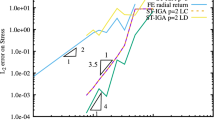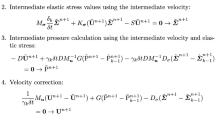Abstract
The generalization of a new numerical approach with simultaneous space–time finite element discretization for viscoelastic problems developed in the papers by Buch et al. (1999) and Idesman et al. (2000) is presented for the case of the generalized viscoelastic Maxwell model. New non-symmetric variational and discretized formulations are derived using the continuous Galerkin method (CGM) and discontinuous Galerkin method (DGM). Viscoelastic behaviour described by the generalized Maxwell model is represented by means of internal variables. It allows to use only differential equations for the constitutive equations instead of integrodifferential ones. The variational formulation reduces to two types of equations with total displacements and internal displacements (internal variables) as unknowns, namely to the equilibrium equation and the evolution equations for the internal displacements which are fulfilled in the weak form. Using continuous test functions in space and time, a continuous space–time finite element formulation is obtained with simultaneous discretization in space and time. Subdividing the total observation time interval into appropriate time slabs and introducing discontinuous trial functions, being continuous within time slabs and allowing jumps across time interfaces, a more general discontinuous finite element formulation is obtained. The difference between these two formulations for one time slab consists in the satisfaction of initial conditions which are fulfilled exactly for the continuous formulation and in a weak form for the discontinuous case.
The proposed approach has some very attractive advantages with respect to semidiscretization methods, regarding the possibility of adaptive space–time refinements and efficient parallel processing on MIMD-parallel computers. The considered numerical examples show the effectiveness of simultaneous space–time finite element calculations and a high convergence rate for adaptive refinement. Numerical efficiency is an advantage of DGM in comparison with CGM for discontinuously changing (e.g. piecewise constant) boundary conditions in time and for solutions with high gradients.
Similar content being viewed by others
Author information
Authors and Affiliations
Additional information
Received 7 February 2000
Rights and permissions
About this article
Cite this article
Idesman, A., Niekamp, R. & Stein, E. Finite elements in space and time for generalized viscoelastic maxwell model. Computational Mechanics 27, 49–60 (2001). https://doi.org/10.1007/s004660000213
Issue Date:
DOI: https://doi.org/10.1007/s004660000213




